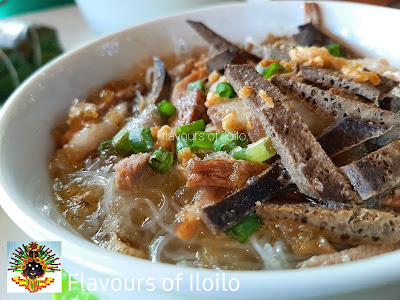And here's another batchoyan that would make your crave for this delectable Ilonggo noodle dish.
This time you eat the noodles, pork, innards and chicharon then sip the caldo in a rustic setting - a quaint bahay kubo under the shade of rustling trees.
Barely a month old, Tay Rudy's batchoy is already making a name for itself among the townsfolk.
Served at Payag Evelyn Batchoyan in Brgy. Bolong Oeste in Santa Barbara, Iloilo, this batchoyan has the making of a hole in the wall as more and more people are discovering this place.
Getting There
Your landmark is Wilcon Home Depot in Santa Barbara along the highway that connects Iloilo City and the Iloilo International Airport. Across is a branch office DPWH with a road going to the Western Visayas Sanitarium.
But you won't reach the hospital as you will have to turn right towards a cemetery and another right then left. Confused? Just ask around when you enter the road, its the only batchoyan in the area.
Payag Evelyn
At the end of the road stands this native hut which locals would typically refer to as payag. A bahay kubo made with bamboo - from it walls and flooring, to its nipa roofing giving you the feeling of being transported to a far-flung uma or farm in the barrios, which gives the place an authentic rural vibe.
And if you're lucky and right on time, the owner will be there to accommodate and make you feel right at home.
Known to many as Inang Lakwatsera ( check out his Facebook page for his humorous yet informative travel vlogs), Rolyn "Bugz" Vista shares that it was an out of nowhere idea that this batchoyan came to be.
As 2020 came to a sudden stop, all his lakwatsa (travels) were affected and instead of using his budget for other things, he opted for a tambayan place for his family and friends.
The two-storey cottage is good enough to host a small intimate gathering and the second floor housed a small office. Bugz Vista is the municipal accountant of Santa Barbara.
Things changed again and he suddenly thought of having a batchoyan in the namesake of his father, Rudy in a place named after his mother, Evelyn.
Tay Rudy's Batchoy
And now that everything has come full circle, it's time for a taste test.
Batchoy is basically the only food served as it is, well, a batchoyan. As of this writing, there are three variations to the La Paz batchoy they serve.
First is the original batchoy which has meke noodles and pork plus the works - liver, innards, chicharon, garlic, etc.
The second variation has a different noodles and that is bihon plus pork and the works.
And last is the beef batchoy, which uses all-beef instead pork and innards plus chicharon and garlic.
You can order puto to go with it, add hardboiled egg and it comes wih unli-caldo. The broth is less oily with hints of guinamos (shrimp paste). You can season with it soy sauce and pepper according to your taste.
And if you want it to have a kick, add some generous amount of chili sauce, which based on experience doesn't alter the batchoy flavor - just making it spicy.
I love how fresh the meke noodles were and just the right size. So good that you can eat it on its own.
The introductory price starts at PhP 45 for the original, PhP 60 for bihon and PhP 65 for beef.
The place teems with a hungry crowd in the mornings then thins puts by noon and picks ups again by 3pm and finally serving its last bowls by 7pm the most.
Of selfies and surprises
The place can accommodate a quite limited number of guests given the CoViD-19 restrictions. We went there around 2pm and luckily had the place to our selves. Just perfect to take some shots and for others - selfies.
And speaking of selfies, the 2nd floor has been converted to into a lumpiga-style room with a low table with the floor/pillows serving as your seats.
A good place to take that perfect selfie with Tay Rudy's delicious Batchoy atop the simple but stylish Payag Evelyn.
Nami kag Namit gid!
P.S. Don't miss out on Inang Lakwatsera's famous "collection". These might be on display when you get there.
But if there's none, there's a very big one serving as a door handle! Look for it! Who knows you might add another selfie!

















